The Spectra nTier Verde is either a 2U or 4U rack mountable NAS that serves as a secondary storage system. The Spectra nTier Verde is designed for ultimate simplicity, cost effectiveness, and data reliability. The simplicity message is key for this tier of storage, even those with no previous storage experience can easily install the Spectra nTier Verde in less than 30 minutes, from box to production. The nTier Verde starts as low as 24TB raw capacity but can be scaled all the way up to 1.7PB. As user scale up the price per GB drops, starting at around $0.75/GB and dropping all the way to $0.35/GB at maximum capacity.

The Spectra nTier Verde is designed for use cases such as secondary backup, archive, tape cache, and to be used as a digital parking lot. To this end, the nTier Verde product was designed specifically for sequential, low IOPs, large file size type workloads typically suited for archiving large amounts of data. The device is also aimed at handling rapid data escalation and data retention policy changes. Though it would work fine with general IT (especially if IT resources are limited, with its ease of use and setup), it would be ideal for use in media and entertainments, HPC, data analytics, video surveillance/security, and federal/SLED use. Along with mirroring, the Verde supplies double- and triple-parity options (2 or 3 drive failures could happen per parity group without the loss of data).
The Spectra nTier Verde comes with a 1-year warranty for hardware and software and comes with a starting street price of $16,000 for the 2U and $31,500 for the 4U.
Spectra nTier Verde Specifications:
- Form Factor: 2U/4U
- Minimum node capacity: 24TB/40TB
- Maximum node capacity: 44TB/140TB (176TB 4U expansion node)
- Maximum system capacity 220TB (1 master, 1 expansion)/1.7PB (1 master, 9 expansions)
- Network connectivity: 3 x 1GbE, 2 x 10GbE
- External ports
- 8x SAS2 ports (6Gbps)
- 4x RJ45 Gigabit Ethernet LAN ports (1 Management, 3 Data)
- 1x VGA port
- Environmental:
- Operating Temperature: 10°C to 35°C (50°F to 95°F)
- Non-operating Temperature: -40°C to 70°C (-40°F to 158°F)
- Operating Relative Humidity: 8% to 90% (non-condensing)
- Non-operating Relative Humidity: 5% to 95% (non-condensing)
- RoHS Compliant
- Power:
- Power supply (with Digital Switching control & PMBus 1.2): 1280W High-efficiency (95%+) power supply
- AC Input:
- 1000W Output @ 100-140V, 12-8A, 50-60Hz
- 1280W Output @ 180-240V, 8-6A, 50-60Hz
- Physical:
- Dimensions (W x H x D):
- 2U: 17.2 in. x 3.5 in. x 27.5 in.
- 4U: 17.2 in. x 7 in. x 27.5 in.
- Weight: 61lbs./104lbs.
Design and Build
The Spectra nTier Verde comes as either a 2U or 4U rack mount. It has a LED-backlit green grill that covers the front of the device with company branding in the center and a rainbow light show like no other bezel we’ve seen. Removing the grill gives access to the drives as well as the user controls on the front of the array. On the left hand side is the power button, reset button and status lights indicating drive activity, network activity, system overheat, and power failure.

The rear of the device houses dual power supply inlets are on the upper left hand side. In the upper middle of the device is the 1GbE connectors and a VGA port. Going to the right of these ports are two 10GbE ports for additional high-speed Ethernet connectivity. The rear side also contains 12 additional 3.5″ HDD slots that come populated in this model.

Management
The Spectra nTier Verde has a streamlined GUI, StrataView Interface. Once everything is setup and ready to go, users will arrive at a dashboard that shows the system and its performance. At the top of the screen are four tabs for dashboard, configuration, status, and support.
From the main screen users can view all information relating to the usage of the storage pools and volumes, network configuration or performance stats. From this main portal window you can also drill into the configuration, status and support pages.
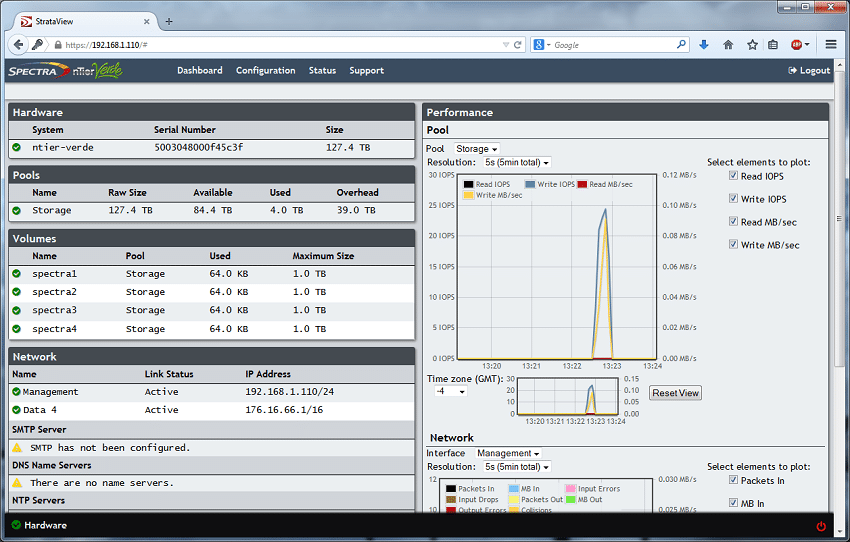
In our review we configured the array in both RAID60 as well as RAID10 for performance versus reliable capacity modes. In the following screenshot we show the storage pool status with the array configured in a RAID60 mode with dual drive parity.
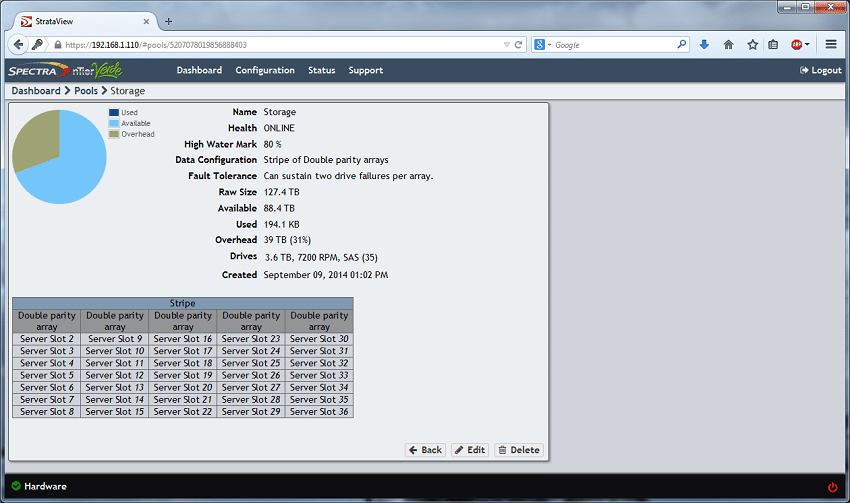
Shares can also be created through the configuration tab. In this case we are creating four CIFS shares for our synthetic benchmark testing. Currently the way the user permissions are handled, only once connected to an Active Directory environment will additional user permissions be created. So unlike other NAS platforms, local user management isn’t included through the WebGUI management.
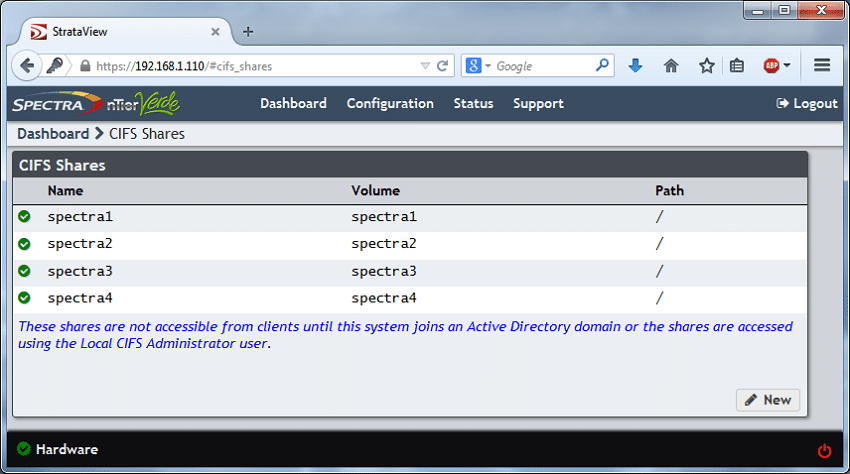
Users can create volumes through the dashboard to mark where their data is stored. They have to name the volume, choose the pool, and then set the minimum and maximum size for the volume. You can also select additional options such as read-only storage or enable/disable compression.
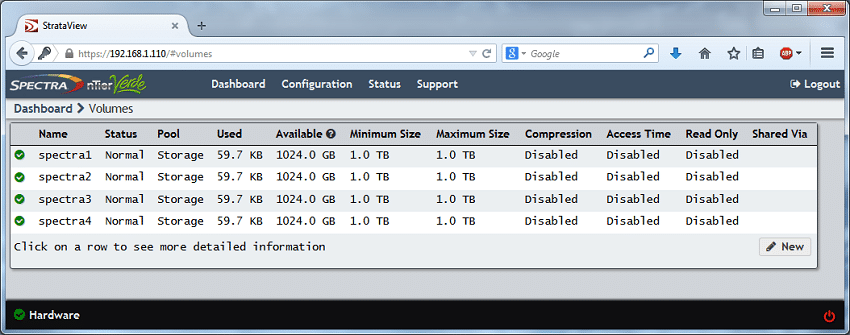
Testing Background and Comparables
We publish an inventory of our lab environment, an overview of the lab’s networking capabilities, and other details about our testing protocols so that administrators and those responsible for equipment acquisition can fairly gauge the conditions under which we have achieved the published results. None of our reviews are paid for or overseen by the manufacturer of equipment we are testing.
The Spectra nTier Verde is being tested in our SQL Server 2012 environment, although unlike most of our performance tests that measure TPC-C performance, this one looks at backup performance while leveraging our benchmark to create change within a given database. For this side by side comparison, we use SQL Server’s internal CIFS backup pointing to a traditional share on the nTier Verde as well as one backup pointing to a share with compression enabled. We tested the Spectra nTier Verde leveraging SQL Server 2012 with a 10GbE connection to the array. For our CIFS tests we used the native backup support built into SQL Server. In both configurations we used 4 streams to maximize the bandwidth across each interface. Each of the 10GbE test routines includes seven runs. The first is a full SQL back up job. Runs 2-4 are full backups with no changes to the database. The fifth run is a backup after the TPC-C benchmark runs, essentially causing wholesale changes to the underlying SQL database. The last runs again reflect no database changes.
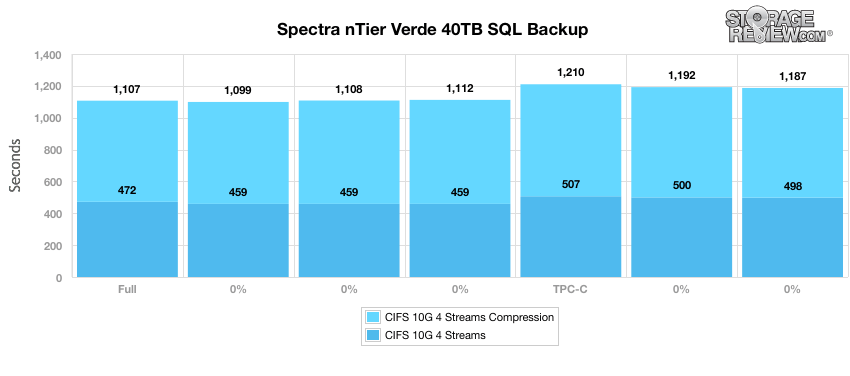
In the test measuring CIFS 10GbE vs. CIFS 10GbE w/compression over 4 streams, we see big increase in the backup window with compression enabled. The difference is greater than 2x, although depending on the database size and the length of window you can build into your backup schedule it could be worth it. In our tests the total data backed up without compression measured 1.6TB after 7 backup runs compared to 1.2TB with compression enabled.
Enterprise Synthetic Workload Analysis
Our set of results will present the Spectra nTier Verde in two storage modes, RAID10 and RAID60 to look at one configuration optimized for performance with one aimed at capacity.
Our enterprise storage benchmark process preconditions each device into steady-state with the same workload the device will be tested with under a load of 16 threads with an outstanding queue of 16 per thread, and then tested in set intervals in multiple thread/queue depth profiles to show performance under light and heavy usage.
- Preconditioning and Primary Steady-State Tests:
- Throughput (Read+Write IOPS Aggregate)
- Average Latency (Read+Write Latency Averaged Together)
- Max Latency (Peak Read or Write Latency)
- Latency Standard Deviation (Read+Write Standard Deviation Averaged Together)
Our Enterprise Synthetic Workload Analysis includes four profiles based on real-world tasks. These profiles have been developed to make it easier to compare to our past benchmarks as well as widely-published values such as max 4k read and write speed and 8k 70/30, which is commonly used for enterprise systems.
4k
- 100% Read or 100% Write
- 100% 4k
8K (Sequential)
- 100% Read or 100% Write
8k 70/30
- 70% Read, 30% Write
- 100% 8k
128K (Sequential)
- 100% Read or 100% Write
With workloads composed of random 4k operations, the Spectra nTier Verde reached its highest performance of 3,915IOPS for write operations and 307IOPS for read operations with the RAID10 configuration. With the RAID60 configuration we saw the Spectra nTier Verde hit performance numbers of 1,417IOPS write and 221IOPS read.
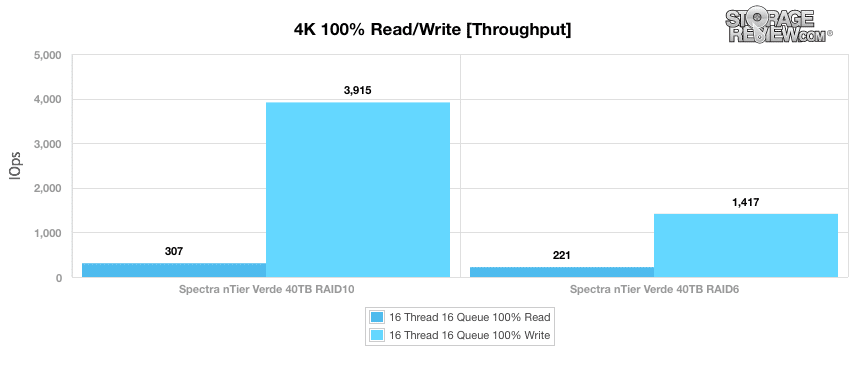
The RAID10 configuration also achieved the lowest latency with 830.96ms read and 65.36ms write. The RAID60 configuration had speeds of 1,154.27ms read and 180.75ms write.
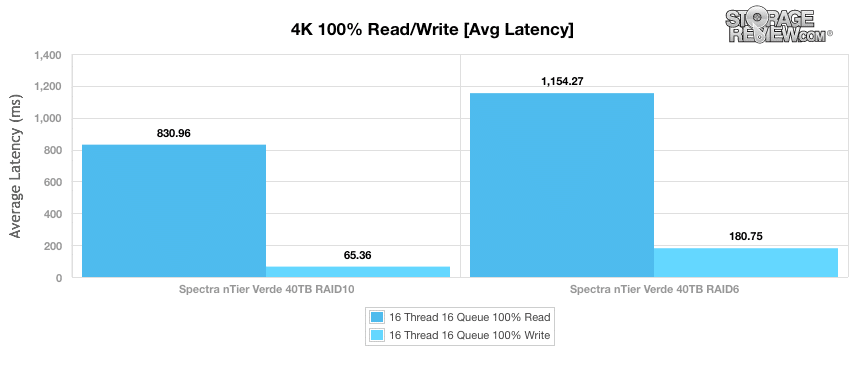
Max latency paints a similar picture with the RAID10 hitting speeds of 1,679ms read and 1,420ms write and the RAID60 had speeds of 2,177ms read and 2,224ms write.
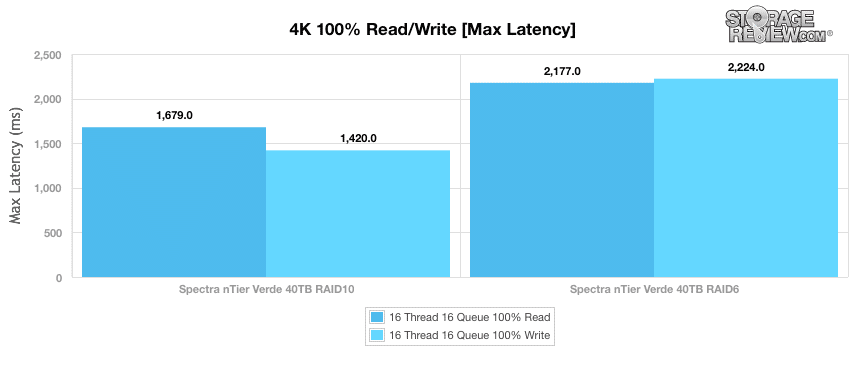
And unsurprisingly the standard deviation showed similar results to the above. The RAID10 configuration had latencies of 310.06ms read and 171.61ms write. The RAID60 configuration had 197.96ms read and a slightly bigger jump to 408.08ms write.
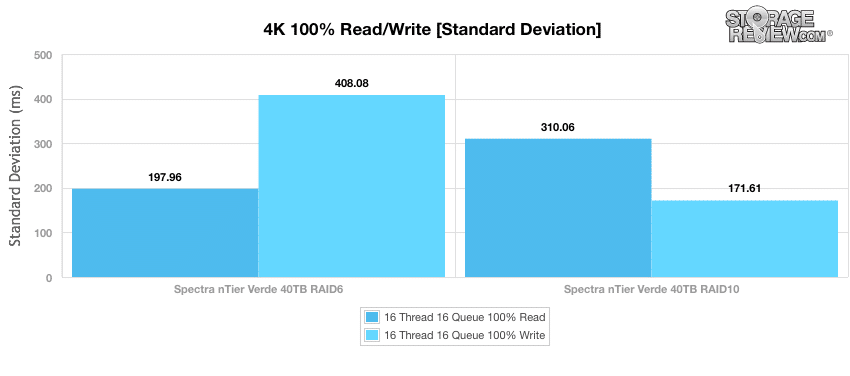
After reconditioning the array for sequential 8k transfers, we measured throughput with a load of 16 threads and a queue depth of 16 for 100% read and 100% write operations. The Spectra nTier Verde RAID10 configuration had a throughput performance of 16,354IOPS read and 19,399IOPS write. The RAID60 configuration came out on top however with throughput performance of 16,738IOPS read and 19,575IOPS write.
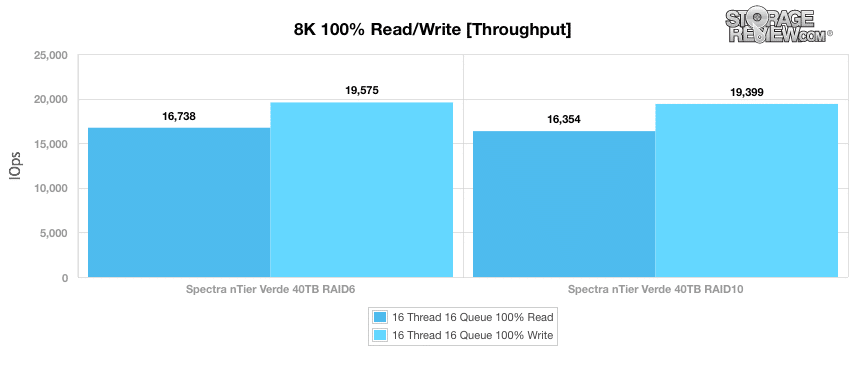
The next results are derived from a protocol composed of random 70% read operations and 30% write operations with an 8k workload across a range of thread and queue counts. The RAID10 had an overall higher throughput from start to finish, though both configurations started out higher and dropped into higher queue depths.
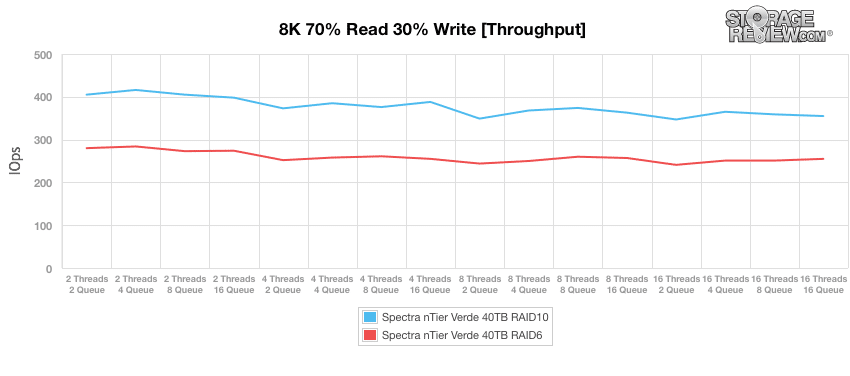
Looking at average latency we see that the RAID10 configuration had faster response times throughout.
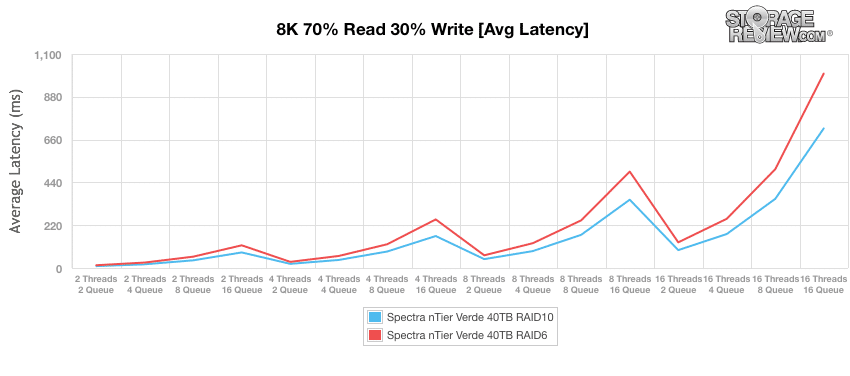
Looking at max latency the RAID10 configuration was again the overall better performer though the RAID60 configuration ran with it neck and neck at times.
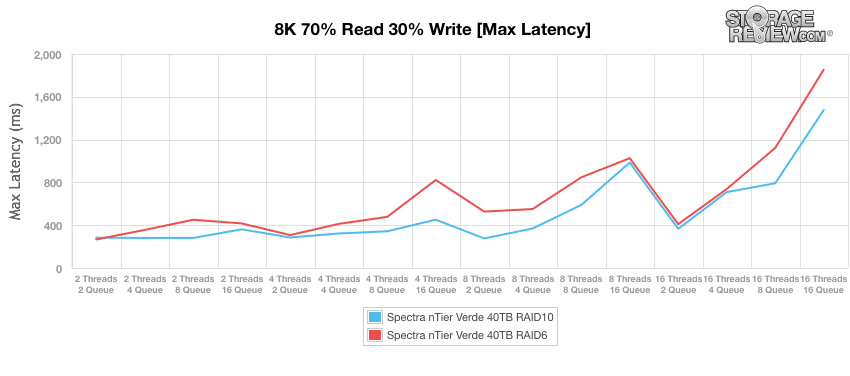
With standard deviation we again see the RAID10 configuration as the top performer but the RAID60 ran much closer throughout this time.
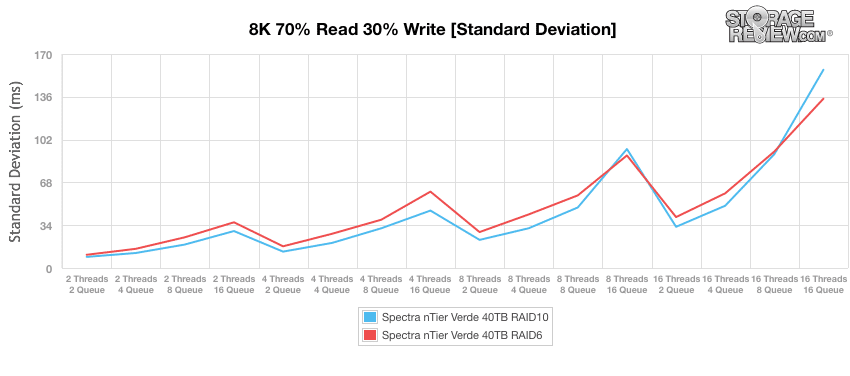
Our final synthetic benchmark is based on sequential 128k transfers with 100% read and 100% write operations. The Spectra nTier Verde RAID10 configuration had the greatest performance with 995,914KB/s read and 542,998KB/s write while the RAID60 configuration had 935,920KB/s read and 488,185KB/s write.
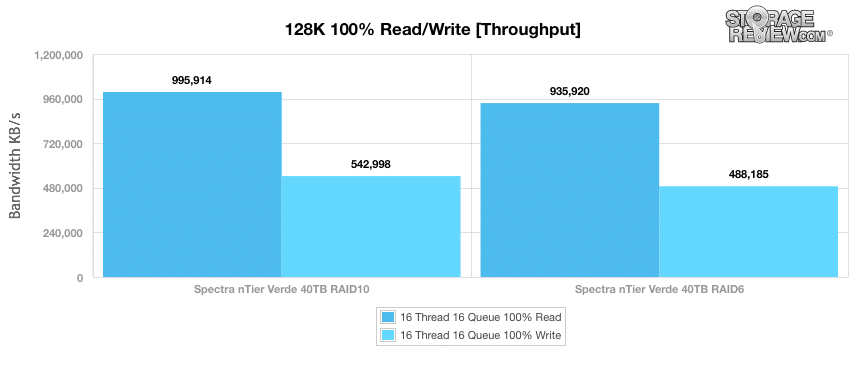
Conclusion
The Spectra nTier Verde is a rack mount NAS used primarily as a secondary storage device for bulk data. It comes in both 2U and 4U form factor and runs from 24TB of raw capacity all the way up to 1.7PB. It has a simple setup, claiming 30 minutes from box to production, though we did it in less. Once up and running the GUI offers intuitive management with a dashboard that pulls together the most relevant items. The nTier Verde has some of the lower aggregate cost of data storage around, running at $0.35/GB in the higher capacity version, ideal for this tier of data.
In our tests we positioned the Spectra nTier Verde as a backup appliance in our Microsoft SQL Server 2012 environment. Measuring the performance of SQL Server’s native backup performance over CIFS, we compared the Spectra nTier Verde in two configurations; one with raw storage and another with compression enabled. Our test consisted of timing seven full backup runs to see how the Spectra nTier Verde performed over a 10GbE fabric. The net result showed about a 2.3x increase in backup window with compression enabled, although a net savings over using raw storage of 1.2TB consumed vs 1.6TB without.
For our enterprise workload testing, we measured and compared RAID10 and RAID6 configuration on the Spectra nTier Verde. We found random 4K access performance to top at 3,915 IOPS for write and 307 IOPS for read. With our 8K performance, the Spectra nTier Verde showed a top performance of 16,738IOPS read and 19,575 IOPS write. And we found the device to have large-block sequential speeds at 996MB/s read and 543MB/s write.
Overall the system is quite flexible and is being positioned with many partners like CommVault and Veeam to bring solutions-oriented packages to market. Given its ease of use paired with data compression, the Verde finds a unique, almost do-anything, segment for itself. Because it’s not shoehorned into a single specific use case some may look past nTier Verde, but its ability to be somewhat of a storage chameleon enables more use cases and options when it comes to storing lower-tier data.
Pros
- Easy to setup and deploy
- Low cost per GB
- Data compression saved 25% over raw storage with our SQL backup
Cons
- 2u model only allows one expansion slot
- No deduplication support
The Bottom Line
The Spectra nTier Verde is a secure, cost-effective, and easy to setup and use secondary backup appliance with plenty of scalability and performance for lower-tier data needs.




 Amazon
Amazon